Stepping in Vámbéry's footsteps
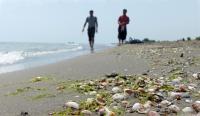
In 2005 I cycled approximately 300km on the shore of the Caspian Sea, just in the opposite direction. I was amazed that I could not recognise any of the places I went by. Iran changed a lot. At the launch of the expedition I was still unsure about if I should or shouldn’t visit the 15 million populated Capital, Tehran. It is not the best choice on a bike... but as I had time, my plan was to make a larger detour from Tehran, this time to Shiraz, following the second route of Vámbéry.
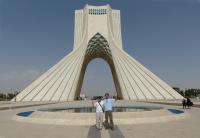
After arriving to Chalus I informed my friend, Payam (I stayed for a week with his family in 2005). I left my bike at a relative of Payam’s and only took the most important of my equipment with me. I took a taxi to cross the Alborz Mountains. I was again amazed by the landscape. In the past I rode through here on my way from Tehran, and now, 8 years later, I shocked how I was able to manage it in just two days. The track is a continuous uphill from sea level till 2600m. It follows next to the Amir Kabir Dam, to the town of Karaj, and then it connects to the gigantic metropolis, Tehran.
The city of Shiraz is located in southwest Iran, 942km from Tehran and it is a 12h long bus trip. I spent there two days.
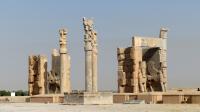
Persepolis – was the ceremonial capital of the Achaemenid Empire, but even now, after 2500 years, it still amazes people. The gigantic pillars, reliefs and enormous stairways capture people’s imagination. “Never shall I forget the night of my arrival at the ruins of Persepolis. It was bright moonlight, and I stood for hours, transfixed in silent wonder, gazing at the gigantic monuments of ancient culture.” – is what Vámbéry wrote in "The story of my struggles" at the beginning of the 20th century. Also the travellers of previous centuries liked to leave their mark as “graffiti” on the ruins. In 1862, when Vámbéry arrived here, he found a mark of a fellow countryman’s previous visit. In his joy he put his own mark bellow and also wrote “éljen a magyar” (“Long live the Hungarian”). It was a marvellous feeling to stand at the same spot Vámbéry was standing 151 years ago...
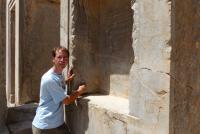
Afterwards through Tehran I arrived at the shore of the Caspian Sea. To tell you the truth I really awaited the moment when I was able to get back in the saddle of my bike, as I find this form of transportation a lot more comfortable.
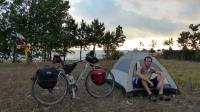
I spent the night on the shore, far away from any civilianization. But there is rubbish also on this shore, also as next to the roads – especially at places where families use to camp. It makes me sad. Sadly people don’t bother to preserve the Nature.
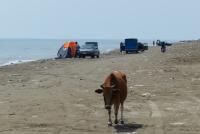
There are rice fields next to the Caspian Sea. This makes it hard to find suitable places to camp. Night was already falling when a car stopped next to me and from the driver came the invitation for my next stay – just in the right time.
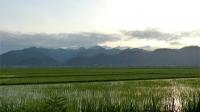
During the night we went to the near town of Gorgan by car, just because someone had to go there. I saw at multiple spots gipsies begging on the street or playing a violin.
Ali told me that these are “kuulook” (gipsies), who aren’t working and that long ago they came from India to Iran. Well, I told him that he don’t have to explain it any longer, we know them as well.

Before going to sleep I read Vámbérys book. Was trying to find my location according to Vámbérys, but I could not find the village Karapete which he described on the map.
The next morning I was amazed to hear that Ali had heard about that place. So we went to find it. Vámbéry described the village with a black hill in the middle (which is Karepete in Turkish), this is from where the village got its name. At that time Vámbéry saw the Caspian Sea for the first time from this location.
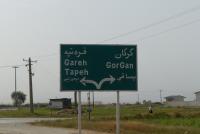
With Ali’s help we found the place called Gareh Tapeh pretty fast. It is located in the middle of the flatland with the hill in the middle, as Vámbéry described. The village is pretty much on Stone Age level. This region is already populated by Turkmen. The main difference between them and the Persians is the religion. The Persians are believers of Shia Islam, the Turkmen are followers of Sunni Islam, and the two religious groups do not like each other a lot. Standing on the top the black hill today you cannot see the Caspian Sea or the bay of Gorgan as the shore is built up. In spite of this it was a marvellous feeling to discover an additional place – far from everything – where at that time Vámbéry visited.
